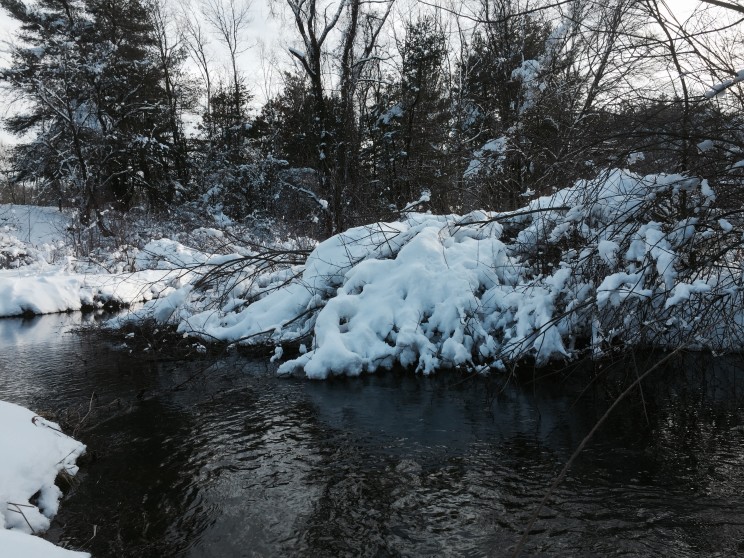
“Fish have to eat.”
If I had a dollar for every time I’ve said that. If you’re a fly fisher, and you’ve gone out in the winter in pursuit of fish, you may have offered that same phrase as part of your explanation to a skeptic. Friends, family members, and concerned passersby might be puzzled at best and, potentially, concerned for your mental and physical well-being.
Why would any reasonable person go outside in the winter and stand in water? If you’ve read the survival stories in Outdoor Life or watched Bear Grylls eat weird stuff, you know that getting wet in frigid conditions is not the best idea. In fact, they say it is, and I quote, “a bad idea.”
So even though you know that you’re all bundled up with the warmest and most waterproof gear, you have to be empathetic. Some sweet old lady, minding her business, drives by a creek and sees an adult walk headlong into a river. The situation could be a little distressing on her part. She could call the police. Or worry about you all day. Or pull over and ask if you’re okay (like, in the head).
This might give you the chance to explain fly fishing, how you like to fish when there aren’t as many anglers around, or just say “fish have to eat.” “Oh,” they may respond, “I never thought about that.”
Why would they? All that science, I don’t understand. It’s just my hobby five days a week. Some critters hibernate. Your average citizen knows that bears and groundhogs do this. They may even have neighbors that burrow in for the winter, mail and newspapers piling up until a March thaw.
But fish? Fish, at least those existing outside of aquariums and seafood counters, are relatively inconsequential to those who aren’t outdoorsy. The whole “standing in a river, waving a stick” thing looks romantic, but it also involves standing in a river. Under the best circumstances that can be unsavory to most folks in the 21st century. Add in the icy blast of old man winter, and you’ve got an activity that now ranks up there in desirability with public speaking and visiting the dentist.
Fish do have to eat. In freestone streams, food is a little harder to come by during winter months. Assuming the river isn’t frozen over, and the temperatures allow fish to feed, they’ll be opportunistic. Spring creeks and tailwaters, at least near their sources, are essentially the same year-round. With a few variables, these fisheries will hold active, feeding fish in both mid-August and mid-January.
So get out there. If local regulations allow for it, and your local municipality has allocated enough funds to plow out roads and access points, you’ll probably have the river to yourself. Midges will hatch, slowly stripped streamers will be enticing, and you’ll get some solitude.
Here are five winter fishing tips to consider:
- It is not a good idea to put hand warmers in the bottom of your waders. The neoprene booties don’t breathe, so you get hot and sweaty feet as you walk to your spot. Then when you get in the water, the pressure cuts off the oxygen. Without air, they don’t function. So your hot and sweaty feet become cold and sweaty feet.
- Fish the same holes you target in the spring, summer, and fall. Unless you’re fishing a hatch, chances are that you are casting to stream cover and structure. Productive rocks, logs, undercut banks, and current seams during the “in season” will continue to be worth your attention when its cold out. Fish will always seek out warmer water in the winter, but all things being equal they will look for the same locations for protection and sustenance. Don’t overestimate an organism with a brain the size of an egg pattern.
- Dress for success. It is not fun to be cold. At best, you’re miserable and not giving fishing your all. Worst case scenario, they find you 5,000 years later, thaw you out, and give you a name like Ötzi. Neither option is ideal. I’ve spent some time talking about the relative ease of dressing properly. Cotton is a no-no. Layers and an option for storing layers is key. And a fashionable hat is always helpful.
- Don’t stand on the ice. If you’re fishing a river, the ice that has built up along the bank might seem like a great way to access good fishing without getting wet. Aside from the ill-advised nature of walking on ice over moving water, wading boot soles are about as bad for traction as you can get. I saw a friend do a cartoon fall on some streamside ice: slipped, went perfectly horizontal, and landed flat on his back. The ice cracking underneath him was a nice, comical touch.
- Take the opportunity to go somewhere new. As mentioned above, tailwaters and spring creeks will be pretty consistent throughout the winter. Near their dams or springs, the water will be a good temperature. That can and does draw anglers, but the crowds are also mitigated by the cold air temperatures. Rivers that get hammered in the spring, summer, and fall will probably be much more open, and have fish that are less pressured, during the winter months. Just make sure you check the regulations.
Remember: fish have to eat. If you “have to fish,” there isn’t a problem. As long as there is open water that allows it, some great fly fishing can be had in the winter.

Hey Matthew! Just found your podcasts and love them. Just moved out to western MA. Where do you like to fish in the winter? Looking to get out there.
Hi Bob, thanks for the kind words.
The Deerfield is a great river, even in the winter. Enjoy!